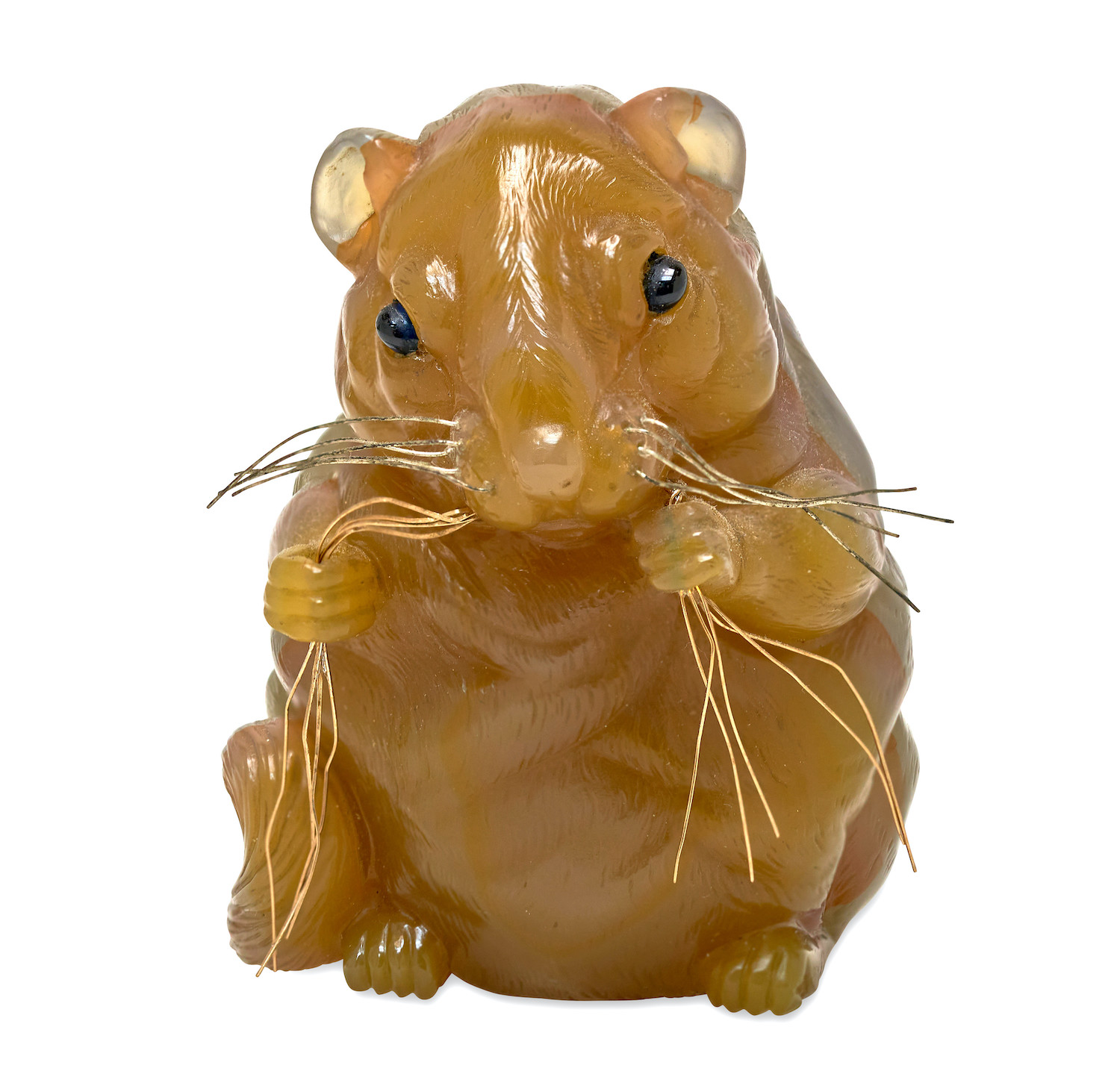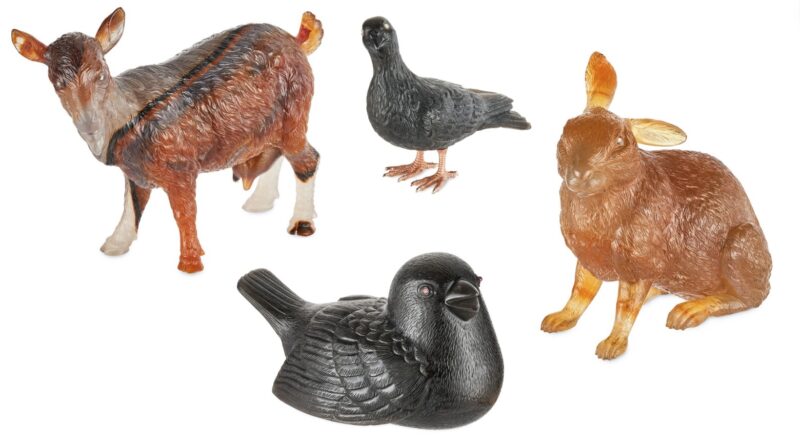Big results for Fabergé miniature animals
A historically important stand-alone collection of Fabergé hardstone carved animals caused much excitement when it was offered for auction at Elmwood’s in London recently.

The auctioneers reported fervent bidding from around the globe to try to secure one of 20 of Faberge’s finest creations to date, with many of them contained within their original fitted cases from Fabergé. The collection achieved a staggering £2 million against a pre-sale estimate of £1 million, more than doubling its pre-sale estimate.
The historic collection drew much attention, as it had been assembled with a focus on provenance, quality and condition of each individual piece. Many of the animals came from the collection of the Russian Imperial family, and have since been owned by British aristocracy, European Royal families, as well as some of the most prominent collections in the world. This has seen many of them with rich exhibition history around the world, which accounted for the exceedingly high prices achieved.

The showstopper of the sale was a rare Fabergé jewelled obsidian model of a dust bathing sparrow in the Japanese taste, modelled after an ebony Netsuke by Horaku. It sold for £525,000, far exceeding its estimate of £40,000-£60,000 to a Japanese collector.
Fabergé and netsuke
The great Carl Fabergé was passionate about netsuke – Japanese decorative pendants, worn on men’s kimonos and it was this that inspired him in (1900), to create a range of charming miniature animal carvings. For them, he used different types of hardstone, in order to demonstrate the rich varieties of Russian stone, sourcing the best available from the stone-carvers of Ekaterinburg and Karl Woerffel’s lapidaries. They proved popular and after the opening of the first shop outside Russia (in London in 1903), Carl tailored the animals for his growing British clientele.

Top Lots
Among the other top lots was an extremely rare jewelled silver and gold mounted life-size agate model of a dormouse. It was given as a gift by the great Emmanual Nobel (1859-1932), who was instrumental in establishing the Nobel Foundation and Peace Prizes, to Karl Wilhelm Hagelin (1860-1955), a pioneering engineer working with Nobel in his family’s oil business. The honey-coloured striated agate dormouse seated, chewing on threads of straw made from gold, held in its hands, was set with cabochon blue sapphires. Dating from circa 1900, it realised £143,750 against an estimate of £80,000-£120,000, selling to a UK buyer.
A Fabergé gold mounted jewelled agate model of a duckling which was once the property of Emily Yznaga, sister of the Duchess of Manchester and the renowned collector Harry Woolf, demonstrated the continued desire for exceptional lapidary work. It achieved £130,000 against an estimate of £30,000-£50,000, selling to a US buyer. A beautifully carved Fabergé model of a Hare with its ears charmingly positioned in an alert stance, proved very popular achieving £118,750 against an estimate of £35,000-£45,000, selling to a US-based bidder.
Another colourful animal within the collection in its original fitted case, was a Fabergé jewelled agate model of a rabbit, which instigated heated bidding between a telephone and online bidder. It soon eclipsed its estimate of £35,000-£55,000 selling to a UK collector for £115,000.

against an estimate of £35,000-£55,000
Commenting on the spectacular result of this historical collection, Elmwood’s auction house, said: “We are thrilled with the result of today’s sale, which is testament to the exceptional provenance of each piece in the collection. This was the culmination of the hard work of the Elmwood’s team, working closely with our global network of buyers.
All of these factors contributed to many pieces far exceeding their estimates. We saw lively bidding from around the world on the telephones, as well as online, with fierce competition for the top lots. With many of these pieces not being offered on the open market for decades, or even ever, clients saw a unique opportunity to acquire these exceptional pieces to treasure for years to come. We were particularly delighted with lot 15, which saw a bidding war lasting over 10 minutes between two telephone bidders, before it finally won out to a Japanese Collector, for the staggering price of £525,000, far above its £40-£60,000 estimate.”
An animal from the Imperial collection was a gift from Grand Duchess Olga Alexandrovna of Russia (1882-1960), to her aunt, Princess Thyra of Denmark, Duchess of Cumberland, for Christmas in 1907. The naturalistically carved animal was a jewelled gold-mounted obsidian model of a carrier pigeon, with its head tilted to one side in an inquisitive pose. Its eyes were set with rose cut diamonds and it stood on finely chased gold feet and legs. Dating from 1907 it was accompanied by a handwritten note in English: From Olga of Russia Xmas 1907. It sold to a European buyer for £100,000 against an estimate of £30,000-£50,000.

About Peter Carl Fabergé
Peter Carl Fabergé (1846-1920) trained in Jewellery-making from leading goldsmiths across Europe and also trained at Schloss’s Commercial College in Paris, where he was fascinated by the historical works in Europe’s top museums. In 1864 he took over the Fabergé business in St Petersburg, from his father, who had founded it in 1842. It was already well-reputed for creating fine jewellery for the gentry, but on joining, Carl Fabergé soon elevated the company to become the official goldsmith to the Russian Imperial Court. The company designed and produced exquisite jewels and objects, including the famed series of luxurious Imperial Easter Eggs.
Carl was well-known for his artistic use of colour and opulent embellishments. He also cleverly worked to the unique characteristics of the stones used and his global reputation drew in the aristocracy, Royalty, business magnates, entrepreneurs, as well as artistic and academic clientele.
The animals were also carved to give them their own distinct personality, with often comical characteristics. When the carving was finished Fabergé’s head workmaster would polish the animal and set it with various features, such as eyes set with diamonds, or other precious stones, such as rubies and sapphires and claws or legs would often be augmented by gold.
They became highly collectable, with clients such as Queen Alexandra (1844-1925), who in 1907 commissioned Fabergé to create an entire menagerie of carved animals, based on the animals from their Sandringham country estate, which would result in the largest group of Fabergé’s hardstone animal carvings ever known at the time and included the King’s bear. Grand Duke Michael Mikhailovich (1861-1929) and his wife Sophie of Merenberg, Countess de Torby (18681927) formed a collection specifically of Fabergé’s elephants. The miniature animals remain amongst the most popular collectable items from Fabergé.


